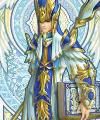History of El Santo Nino de Atocha (The Holy Child of Atocha)
The devotion to El Santo Nino de Atocha originated in Spain. Its origin may be related to Our Lady of Atocha, in Madrid, Spain, who is mentioned in the "Cantigas" of King Alphonse the Wise in the 13th century. During medieval times, the Moors held large areas and battles between the Christians and Moors were commonplace. The Moors invaded the town of Atocha. Following a certain battle, the victorious Moors held a great many Christians captive, and prevented the adult villagers from visiting as well as bringing the prisoners food or water. Fearing for the lives of the prisoners, their families stormed heaven with prayers for relief. One day, a child appeared, dressed as a pilgrim of that period, carrying a basket of food and a gourd of water. The Moors allowed the child to bring food and water each day. The prisoners were fed, but the basket and gourd remained full. The child was not known to the Christians nor to the Moors, so the people concluded that the child Jesus, disguised as a pilgrim, had come to their rescue.
In artwork, the Holy Child often wears a brimmed hat with a plume and a cloak or cape ornate with the St. James shell. (During the Crusades, scallop shells were the symbol of holy pilgrimages and one European variety is still referred to as "the pilgrim" or "St. James' shell." Poets have written about their beauty and artists have admired their symmetry and grace.) In his left hand, He carries a pilgrim's staff to the gourd of water is fastened, a pair of shackles, and a few spears of wheat. In his right hand, He holds a basket which generally contains bread or flowers. He either wears sandals or is barefoot. The Child is said to roam the hills and valleys, particularly at night, bringing aid and comfort to the needy, and thereby wearing out his shoes. He is usually shown seated.
The original statue of the Holy Child of Atocha was imported from Spain and now resides in the little town of Fresnillo, Mexico. El Santo Nino de Atocha is the patron saint of those unjustly imprisoned. He also protects travelers and rescues people in danger.
SANTO NINO DE ATOCHA IN NEW MEXICO
"WEAR OUT YOUR LITTLE SHOES TRAVELING AT NIGHT PERFORMING MIRACLES"
El Santuario de Chimayo is located in Northern New Mexico in a small town noted for its weavings and red chile. Founded many years ago, it is famous for "holy dirt" that brings about miraculous cures and the crucifix of Senor de Los Esquipulas carved from a wood unknown in NM. Annually during Holy Week thousands of pilgrims come from all parts of the world and all over NM usually walking from 10-60 miles, some carrying heavy crosses. Santo Nino de Atocha (Jesus as a child) resides in this church.
Maria Martinez, the famous potter from San Ildefonso Pueblo was brought to the Santo Nino Santuario in 1890 by her mom when she was very ill. Her mom had made a promesa (vow) that if Maria recovered she would make a pilgrimage to the Holy Place of Chimayo. Little Maria rubbed herself all over with the sacred earth while her mom offered prayers to the Holy Child.
Many villagers believed that the Santo Nino image was found in the hole where the sacred earth is found. A story was told about a man, along with his young daughter, plowing his fields with oxen. She heard church bells ringing in the ground and begged her father to dig them out. He discovered the bells and a wooden statue of Santo Nino De Atocha. Many miraclous cures have been attributed to the Santo Nino. It is believed that Santo Nino travels throughout the country at night wearing out his shoes while performing miracles. Pilgrims frequently bring little pairs of baby shoes to place at the feet of Santo Nino as offerings to replace those he has worn out during his nightly travels. Local villagers sometimes call him Santo Nino Perdido because he is absent from the church at night.
Next door to the Santuario, another church was built around 1850 dedicated to Santo Nino de Atocha. Both churches are open daily where thousands of pilgrims come to give Thanks, pray for healings and leave mementos. The walls of the Santuario are filled with crutches, poems and stories, pictures of loved ones, santos & statues of the saints, our Blessed Mother, and Jesus Christ. Many candles burn brightly as an offering from the pilgrims to remind us that God hears and answers prayers. The candles also reminds us of the deep faith and devotion to God of all the thousands of pilgrims who come great distances with many hardships to keep their promesa (vow).
Prayer to the Miraculous Child of Atocha
All-knowing Child of Atocha, protector of all men, protection of invalids, divine doctor of any illness. Most Powerful Child, I greet you, I praise you on this day and I offer you these three Our Fathers, and Hail Marys, with a Glory be to the Father in memory of the journey that you made incarnate in the most pure womb of your most beloved Mother from the holy city of Jerusalem to Bethlehem.
For the petitions that I make today, I ask you to grant my request, for which I submit these deeds and in unison with the choir of Cherabim and Seraphim, adorned with the most perfect wisdom, because precious Child of Atocha, happy in sending my supplication, I know that I will not be disapointed by you and I will obtain a good death in order to accompany you in the glory of Bethlehem. Amen.
Jesus, under the title of Santo Nino de Atocha, nourished the prisoners with His bread. May we continue to sustain ourselves through the power of His Presence, (Body, Blood, Soul, and Divinity), in the Eucharist. "The bread that I will give, is my flesh, for the life of the world." (John VI, 52)
 [/URL][/img]
[/URL][/img]






